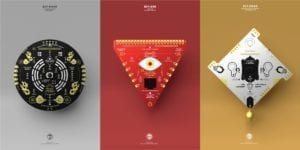Reflection:
Interaction is a procedure of two or more objects effecting each other in various ways in a short period of time. If we split that procedure into closer details in a simple way, it is like what Igoe and O’Sullivan define in Introduction to Physical Computing—interaction is “listening, thinking, and speaking” in human terms from Chris Crawford’s perspective and “input, processing, and output” in computer terms (XX). However, an interactive device must be able to change its output as long as the audience changes its alterable input, while the algorithm is fixed. This definition is enhanced by our group project of the 2119 interactive device and the two projects—Blackberry Winter and BIY™—I found on the Creative Application.
BIY™(Believe it Yourself), created by Shanghai-based design studio Automato.farm, are three different kinds of real-fictional belief-based computing kits. Basically, the kits are using traditional Chinese Geomancy and Fengshui, which is based on rules of positions of mountains and rivers nearby, to tell the fortune. There are three kits that are BIY.SEE, BIY.MOVE and BIY.HEAR. By using the camera in BIY.SEE, users are able to see luck based on their conditions. Meanwhile, BIY.HEAR enables you to learn your destiny by microphone interpretation, and BIY.MOVE is a compass to post out your harmony and balance. Since the personal information and the location is alterable, the output will change while the user changes. The kits Believe it Yourself can be considered as an interactive device that involves “input, processing, and output”.
 Believe it Yourself.
Believe it Yourself.
On the other hand, Blackberry Winter is an artificial human motion in asymmetry. It is “an investigation into the possibilities of identifying motion as a continuous walk in a latent space of situations”. Using a machine learning solution to combine spatial information into a technical network weaving various and huge amount of motions by human bodies, the team created a visualized model to develop artificial human motions. From my perspective, Blackberry Winter is hard to be defined as interactive. Firstly, when the algorithm is fixed, the output won’t change while the input is altered. This means that it is like a fixed video showing in front of the audience, instead of a device that you can play with. Secondly, comparing the differences between Blackberry Winter and the Believe it Yourself, we can see that it is important for an interactive device to be useful—in other words, let the changes in input and output being useful. If we categorize Blackberry Winter as a kind of art, it is not reflective as most of the moves are unable for the human to perform.
 Blackberry Winter.
Blackberry Winter.
After understanding the idea of interaction, we started our group project “Disaster Jacket”, a life preserver in 2119, when natural disasters, like a typhoon, air pollution, earthquake, and other extreme weather, become more likely to happen. We set the scenes and performed the reaction of people with and without the Disaster Jacket to illustrate the function of the life preserver. It has multiple sensors detecting the environment (temperature, moisture, height, position, etc.) around you so that when natural disasters come, it can immediately produce the output. By dropping down the anchor, it can protect you in the typhoon. When you are drowning, the jacket will inflate and activate a light to alert rescue workers to your location. The jacket is defined interactive because it fulfills the criteria of following the procedure of “input, processing, and output”. Meanwhile, it is able to change its output when the environmental inputs change, while the algorithm is fixed. Related to the two projects I researched, the life preserver is useful and meaningful in the age of 2119. The device is focusing on human and user situations, avoiding people to get injured or even die in future natural disasters. This might be a real product in the near future as we already see interactive helmets protecting cyclers’ head when he falls off the bike.
 Our Group Project
Our Group Project
References:
Crawford, Chris. “Art of Interactive Design.” Art of Interactive Design | No Starch Press, nostarch.com/interactive.htm.
https://www.creativeapplications.net/openframeworks/blackberry-winter/